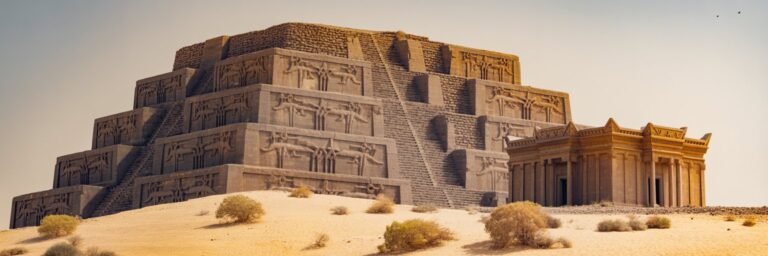INTRODUCTION
The ancient world, adorned by the grandeur of civilizations such as the Roman Empire, the Egyptian Dynasties, the Mayans, or the vast Indus Valley civilization, has been a fertile ground for archeological and historical exploration. Each civilization, unique yet interconnected, represented an apex of human achievement in their respective moments in time, but eventually met with decline and dissolution. Understanding the collapse of such societies, vibrant and prosperous in their heyday, allows us to decipher the non-linear and complex tapestry of human history.
HISTORICAL BACKGROUND
The collapse of ancient civilizations denotes generally to the fall of dominant societies prior to the advent of the Renaissance. For instance, the extensive and organized Indus Valley Civilization (3300–1300 BCE) in what is now Pakistan and Northwest India, boasting large urban centers like Harappa and Mohenjo-daro, disappeared suddenly around 1300 BCE. The once mighty New Kingdom of Egypt (1570–1070 BCE), known for monumental architectures like the Abu Simbel, disintegrated, facilitating foreign invasions. The Mayan civilization (2000 BC to 250 AD), credited for the only fully developed writing system in pre-Columbian Americas, faced a gradual downfall termed as the ‘Mayan Collapse’. The colossal Roman Empire (27 BC–476 AD), perhaps the most iconic civilization in the ancient western world, fell, giving way to the Middle Ages.
THEORIES AND INTERPRETATIONS
Scholars, armed with archaeological, anthropological, and historical knowledge, have proposed varied theories examining these collapses. Environmental changes have often been implicated. The Indus Valley Civilization, for instance, is believed to have been eroded due to a drying climate along with a significant shift in monsoon patterns. Jared Diamond in his book “Collapse” champions this environmental perspective, suggesting that overpopulation, deforestation, and water management issues precipitated the Mayan downfall.
However, politico-economic factors have also been underlined. The New Kingdom of Egypt crumbled under the weight of its own administrative bureaucracy and stifling taxes, along with a series of weak rulers. And the Roman Empire, historians postulate, was beleaguered by a host of issues, including economic instability, military overspending, political corruption, and ‘barbarian’ invasions.
MYSTERIES AND CONTROVERSIES
Myths and controversies often shroud these ancient narratives. The Indus Script, the writing system of the Indus Valley Civilization, hasn’t been deciphered till today, offering no textual insights into their eventual downfall. Disagreements persist on the impact of invasions on these collapses. Some assert that invasions were merely the final blow to already decadent societies. However, others argue that external invasions and migrations, like the Hittites in Egypt and the Germanic tribes in Rome, indeed hastened these collapses. Meanwhile, the mystery of the Mayan collapse remains unabated despite the ‘environmental’ and ‘overpopulation’ theories, as signs of overpopulation are not universally present at Mayan sites.
SYMBOLISM AND CULTURAL SIGNIFICANCE
The collapse of these ancient civilizations, though marred by loss, has symbolic significance, serving to remind us of the dynamism of human society. They underline the necessity of sustainable, reachable growth, of maintaining balance with environmental elements, and highlighting the perils of unchecked authority and division. For example, the Roman Empire’s fall is often allegorically related to modern socio-political issues, prompting cautionary tales against societal complacency and decadence.
MODERN INVESTIGATIONS
Technological advancements have ushered in new methods of investigation into these collapses. Archaeologists today employ geospatial technologies, including GIS and remote sensing, enhancing our understanding of past environments and aiding in linking climate changes to societal collapses. DNA analysis, radiocarbon dating, and similar biotechnological tools are wielding significant insights into population movements, demography changes, and disease spread. Such sophisticated tools, combined with interdisciplinary studies involving politics, economics, and cultural studies, promise more nuanced, comprehensive narratives on the collapse of ancient civilizations.
LEGACY AND CONCLUSION
Despite their collapse, these ancient civilizations bequeathed a rich cultural, intellectual, and technological legacy, shaping successors and continuously influencing modern societies. Indeed, we exist within, and because of, the shadows of these monumental, ancient architectures of human civilization. The fall of Rome sowed the seeds of what would become the nations of modern Europe. The Mayans, despite their collapse, left an indelible mark in various fields, from astronomy to architecture, profoundly influencing subsequent Mesoamerican cultures.
Investigating their downfall, we learn as much about ourselves as about them. These stories of rise and fall are mirrored in our personal and collective lives, in nations and civilizations, in the ebb and flow of human history. They represent a cautionary tale, a reminder of the impermanence of even the most mighty and seemingly invincible of societies. They remind us of the fragility of human constructs in the face of nature’s might and of our own follies. They foreground the need for adaptability, pragmatism, and sustainable growth. They teach us that, indeed, those who cannot remember the past are condemned to repeat it.






